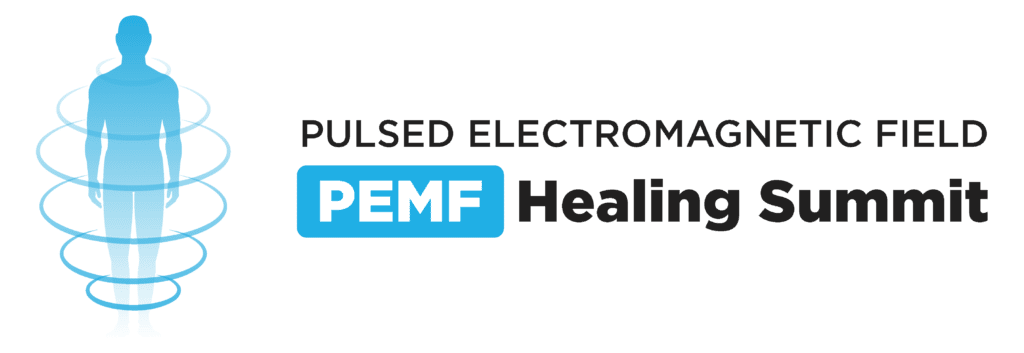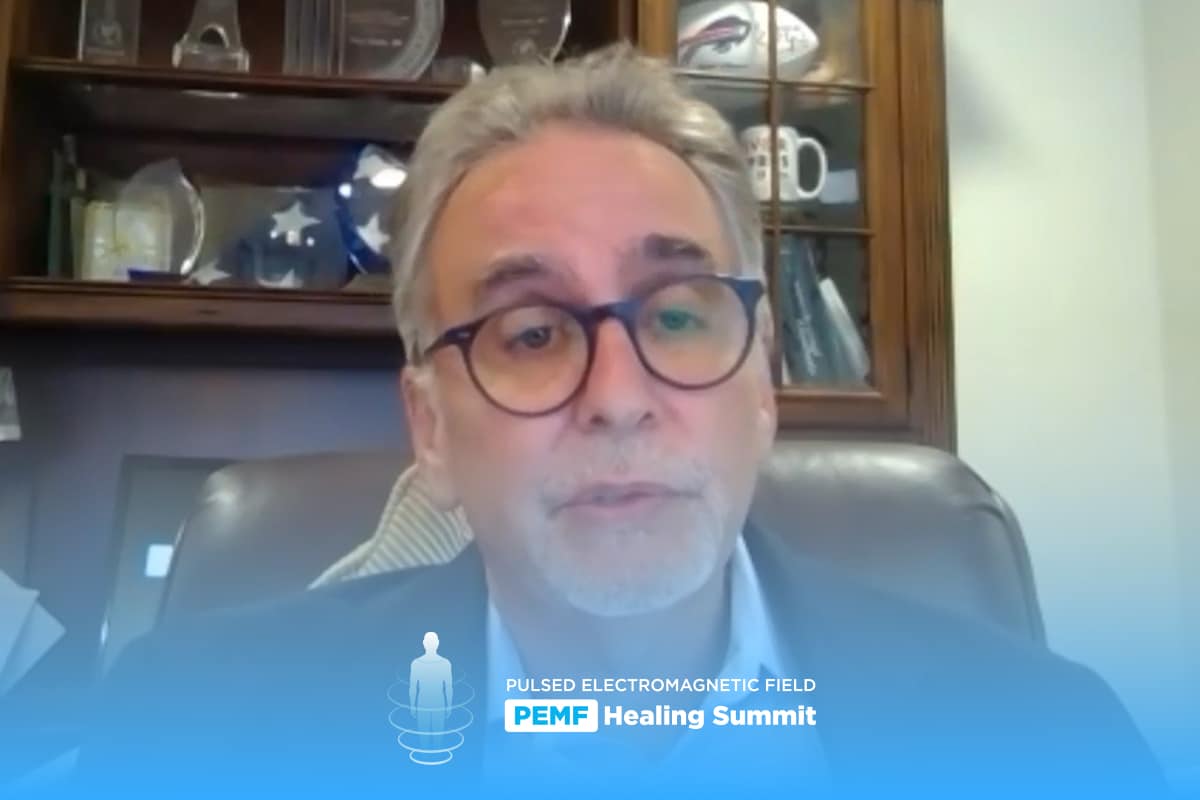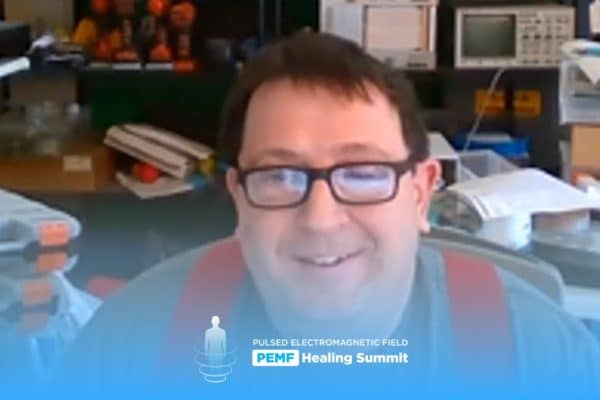Join the discussion below
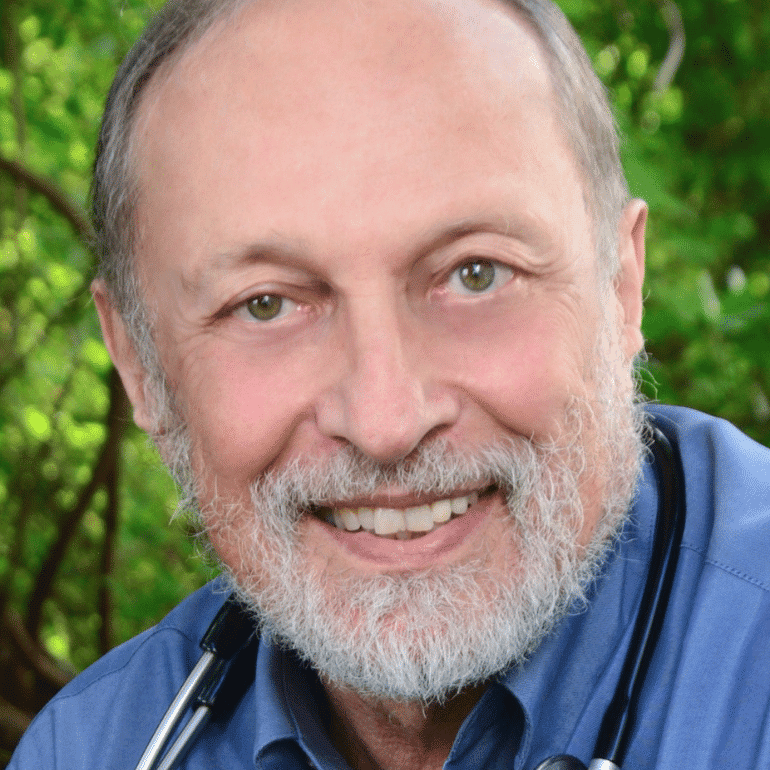
William Pawluk, MD, MSc, author of “Supercharge Your Health with PEMF therapy”, was recently a holistic doctor near Baltimore, MD. Previous academic positions at Johns Hopkins and University of Maryland. Training: acupuncture, homeopathy, hypnosis, energy medicine, nutrition and bodywork. Considered the foremost authority on the practical use of Pulsed Electromagnetic... Read More
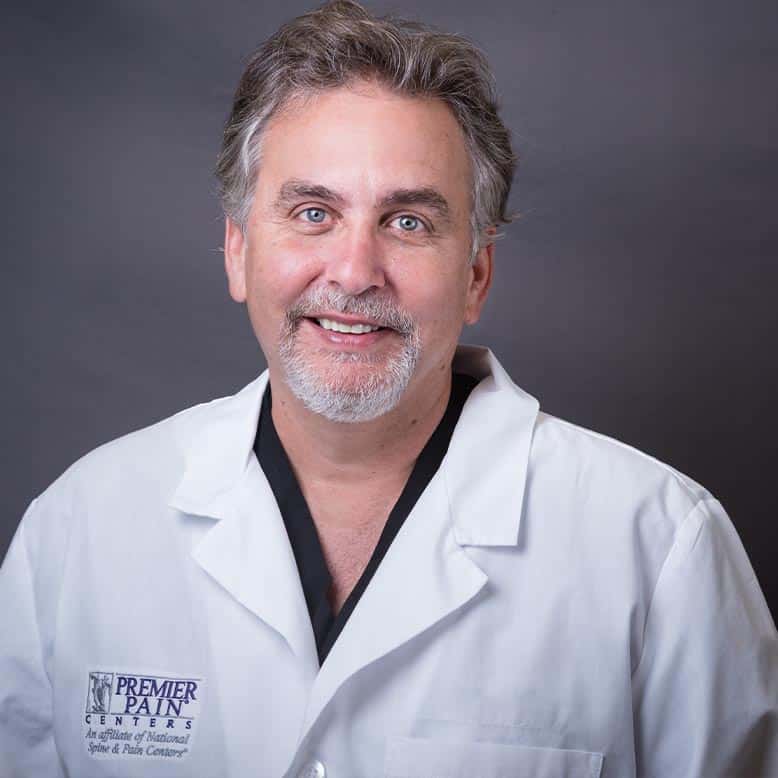
Dr. Staats was founder of the Division of Pain Medicine at Johns Hopkins University, where he was the director for 10 years. Dr. Staats is internationally recognized for his work in inventing, developing, and implementing minimally invasive procedures for pain and neuromodulation. He is currently Chief Medical Officer of National... Read More
- The vagus nerve (VN) is the longest cranial nerve in the body. Stimulation of the vagus nerve especially affects the parasympathetic nervous system. The FDA-approved noninvasive, nonpainful vagus nerve stimulator, the Gammacore, is placed over the carotid artery. It is approved for various types of headaches and can help with the pulmonary inflammation associated with Covid. Even though it’s primarily intended for the approved indications it has all the benefits of stimulating the parasympathetic system including heart and G.I. function, neurological disorders and even mood and anxiety. PEMFs integrate well with VN simulation.
William Pawluk, M.D., MSc
Hi, this is Dr. Pawluk. Today, I have a very important guest, an unusual guest, and somebody who shares a background with me at Johns Hopkins. The title of the interview today is titled “The Power of The Vagus Nerve and Vagus Nerve Stimulation.” And I have with me Dr. Peter Staats. So Dr. Staats is the founder and director of the Pain Management Program at Johns Hopkins. He’s internationally recognized for inventing, developing, and implementing minimally invasive procedures for pain and neuromodulation. He’s currently the CMO, chief medical officer of the National Spine and Pain Centers, and co-founder of electroCore, which is the primary reason for our chat today. He’s also the president of the World Institute of Pain, and he’s the past president of various societies, and they’re too long to list, but a lot of societies, let me put it that way. He’s co-edited 14 books, has over 500 scientific publications on pain management and neuromodulation. He’s been highlighted on “Good Morning America”, “CBS Evening News”, “Newsweek”, and “CNN” at his numerous lifetime achievement awards. Again, too numerous to go into. So I welcome you, Dr. Staats, I look forward to our discussion. All right, so let’s dig in. So this is about the power of the vagus nerve and vagus nerve stimulation. So let’s tell people, first of all, what is this nerve that they probably have heard about? And they know that it’s important. So why is the vagus nerve important and what is it?
Peter S. Staats, M.D., MBA
Well, the vagus nerve is the longest cranial nerve. It’s also called the wanderer, The Wandering Nerve. And this is the nerve that connects the brain with all of the visceral organs, most notably the gut. I think a lot of your listeners might be interested in the mind-body interface, in mind-body interaction. And I’ve been a fan of that, growing up in Hawaii, thinking about Asian medicine for so many years, at my formative years. I’ve always been intrigued by this mind-body medicine, but it’s really the last 20 years where I think I’ve started to get a handle on what that is. And one big aspect of that is the mind and the rest of the body connects via the vagus nerve. This is the information super highway of information going from the gut to the brain, and the brain telling the gut and the chest and the visceral structures how to respond. It’s an incredibly important nerve that, honestly, I didn’t appreciate when I was in medical school or as a resident or as a young attending physician. It wasn’t until much later where I realized that the vagus nerve was so powerful. In fact, it was that nerve that got in my way when I was placing central lines for people who needed to have surgery, but it turns out there is, it’s an incredibly powerful nerve that most physicians, most doctors and many healthcare providers across the United States don’t really recognize it’s important.
William Pawluk, M.D., MSc
As you said, it gets in the way. It’s there and it does its job and we don’t pay attention to it until it doesn’t do its job, right?
Peter S. Staats, M.D., MBA
Right, right.
William Pawluk, M.D., MSc
So let’s clarify one point. You said it’s a cranial nerve. So tell us what cranial nerves are.
Peter S. Staats, M.D., MBA
So there are different cranial nerves, some help you see, some help you smell, some help you taste. And this is a nerve that connects the brain with the gut. It is the nerve that’s going into the brainstem and providing information up to the brainstem. This one in particular, I think, is really important. And I mentioned, a moment ago, kind of the Asian philosophy of yin versus yang. This nerve is the parasympathetic nerve. It’s the main parasympathetic driver, and that’s opposed to the sympathetic nerve. And what we’ve talked about before is the flight or flight, fight or flight response. We’re gonna be really scared, we’re gonna run away or we’re gonna be calm. The sympathetic nerves are the run away, or there’s a bear chasing me. You gotta get excited and run away. The parasympathetic nerves are the calming nerves. And the vagus nerve is one of the main ways where we can cause that calmness to occur. And it turns out that’s really, really important.
William Pawluk, M.D., MSc
Cranial means in the brain or in the head, right?
Peter S. Staats, M.D., MBA
That’s right. Yeah.
William Pawluk, M.D., MSc
It starts up in the brainstem and most of the cranial nerves start in the brainstem. Some of them start in the brain itself, inside the skull.
Peter S. Staats, M.D., MBA
That’s right.
William Pawluk, M.D., MSc
Some of them are just outside the skull, like the brainstem is just outside the skull, but it’s still considered a cranial nerve.
Peter S. Staats, M.D., MBA
That’s right.
William Pawluk, M.D., MSc
And all these cranial nerves, they have feedback back up into the brain, right?
Peter S. Staats, M.D., MBA
That’s right.
William Pawluk, M.D., MSc
The sensory cortex, into the thalamus and the hypothalamus and other structures in the brain.
Peter S. Staats, M.D., MBA
Sure, sure. And this nerve really has very vast, what we call, projections. It goes into one area of the brain called the nucleus tractus solitarius and then it goes out and projects into the, as you mentioned, the thalamus, the hypothalamus, and other areas throughout the brain. Early on, I saw a map of where this goes, and it really does go throughout the brain after the first linkages. And that’s really important as we start to learn about what this does, we’re able to tap into the vagus nerve and change brain chemistry throughout the brain in different structures. So for example, one of the studies that’s being done was completed, showed that we can change brain chemistry in patients with Parkinson’s disease. Another one showed you can change chemistry in patients with post-traumatic stress disorder. And we go down the list of these different types of areas where we’re actually changing the chemistry locally by delivering electrical signals in the neck. So it’s really kind of a fascinating area there.
William Pawluk, M.D., MSc
Now, one of the points you made about the fight-flight response, the brain and the body in general tries to maintain balance.
Peter S. Staats, M.D., MBA
That’s right.
William Pawluk, M.D., MSc
So when you have a fight flight response, fight or flee, that’s your dynamic, you have to act now, in microseconds.
Peter S. Staats, M.D., MBA
Yeah.
William Pawluk, M.D., MSc
But then you have to unwind that, so the body says, okay, I’m up too high now. I gotta bring me down, so it tries to find a balance. And then the vagus becomes stimulated to try to balance out that excessive stimulation of the adrenergic system.
Peter S. Staats, M.D., MBA
Right, and I think teleologically, if you think back to our ancient ancestors, there was very little time of stress. You may be picking nuts or hunting down an antelope when you were thousands and thousands and thousands of years ago. And then there’d be time for relaxation. In today’s world, we don’t really have that same balance of a few moments of stress and a lot of downtime. Today, our lives are just filled with stressful events, either cognitively or driving to work or dealing with an employer, et cetera, so much stress in life has taken us out of balance, I believe. And a way of thinking about this is by stimulating the vagus nerve, we can start to put ourselves back into balance. Now that’s not really a medical definition, but this is a way that I think about things as how do you conceptualize? Or why would you want to stimulate the vagus nerve? What’s gone wrong in our system, in our society that I would need to do such?
William Pawluk, M.D., MSc
Well, it has its own actions, which are not necessarily part of this rebalancing. So you can actually actively stimulate the vagus nerves for specific functions. An analogy that I use for stress is that stress is taking the elevator up, from one floor to the 10th floor, like immediately.
Peter S. Staats, M.D., MBA
Yeah.
William Pawluk, M.D., MSc
It acts really fast. And then de-stressing is a process where the slope is much slower. That’s where the vagus nerve again comes in. You have to process all those neurochemicals that caught, that were part of the stress process. But what happens is that as you’re coming down that long slope, you have all these stressors. So going down that slope is not a linear fashion either, it’s going down steps.
Peter S. Staats, M.D., MBA
Yeah.
William Pawluk, M.D., MSc
Right? It’s a stepwise regression from the initial progression, if you will.
Peter S. Staats, M.D., MBA
Yeah, and that can happen millisecond to millisecond, not minutes to minutes, but millisecond to millisecond where you really need to concentrate on getting your parasympathetics down.
William Pawluk, M.D., MSc
And meditation does that too, right?
Peter S. Staats, M.D., MBA
Yeah, I think there’s a lot of ways to stimulate the vagus nerve. Historically, I think meditation, deep biofeedback and other types of strategies have been used for, to stimulate the vagus nerve to improve the parasympathetic output. But in 1997, the first vagus nerve stimulator was approved by the FDA for implantation, an implanted device for epilepsy–
William Pawluk, M.D., MSc
In the brain.
Peter S. Staats, M.D., MBA
Yeah, on the vagus nerve in the neck, and that was approved for epilepsy. It turns out that in these early studies, and it’s still an active program today, but in these early studies, if you placed an electrode on the vagus nerve and set a certain frequency, you could stop seizures from happening in kids with really severe and recalcitrant seizures. And that’s been around since 1997 or thereabouts and approved by the FDA. So that was one of the early sign that there can be changes in brain chemistry and brain electrical activity by stimulating the vagus nerve. And subsequently, we’ve done work primarily in airway reactivity, and we’ve done work in headache disorders, where we have a whole number of FDA clearances. We’ve got a breakthrough designation from the FDA on post-traumatic stress disorder. And that’s not the same as an FDA clearance, but it’s a sign that the early data is intriguing to the FDA and they wanna fast track this through. In the UK and in Europe there’s approvals or there’s CE mark that they call, for primary headache disorders, for gastrointestinal problems, for airway reactivity or asthma, for epilepsy, and for anxiety and depression kind of relevant to our conversation we just had.
William Pawluk, M.D., MSc
So this is all within the framework of neuromodulation. So neuromodulation is actually a relatively new term, isn’t it? To describe all these kinds of forms of nerve stimulation.
Peter S. Staats, M.D., MBA
Yeah, and so one of my early areas of interest was, when I was at Johns Hopkins, was this field of neuromodulation, the application of electricity to modified disease. And I was actually the first anesthesiologist at any academic institution to implant these devices for chronic pain. And I started to implant spinal cord stimulators for chronic pain back in the ’90s. Others had come before me, but back in the early to mid ’90s, a whole field developed called the field of neuromodulation. And when I was president of that organization back in 2001, I believe it was, we really recognized that this is not about another way of treating pain, but the field of neuromodulation should be a platform for understanding how electricity and site-specific drug delivery can modify disease, not just pain, but maybe pain, maybe schizophrenia, maybe cardiac disease, maybe movement disorders, as you see with deep brain stimulation now for patients with Parkinson’s disease and whatnot. So the field has really broadened from being a very focal area around pain treatment to use of electricity to broadly speak correct diseases. And people are looking at things like rheumatoid arthritis now, which kind of blows people’s mind that we could potentially do that. We got an Emergency Use Authorization in COVID, of all things, for helping with breathing due to COVID. So there’s a lot of ways that electricity can potentially alter diseases. And that’s a new framework. It’s a new thought process for most people to think that, hey, I thought I needed to take a drug. I thought I needed to do have surgery, but it turns out that your body’s pretty powerful if we just give it a little bit of a boost. And that’s back to you, Dr. Pawluk, a lot of the areas of work that you’ve been doing in PEMF. It’s really quite interesting to me how this all kind of comes back together.
William Pawluk, M.D., MSc
Well, part of my journey into PEMF actually started with acupuncture. And as you were chatting, I, again, think back again, that acupuncture, the acupuncture system is a DC current system in the body. A very low level DC current system, very low intensity, but it’s DC current so it’s flowing through all the different organs in the body, including up into the brain.
Peter S. Staats, M.D., MBA
Yeah.
William Pawluk, M.D., MSc
And there are specifically schools of acupuncture that just treat for neurological disorders. So they’re doing, in a sense, neuromodulation too, they’re just doing it indirectly and very, in a very mild fashion. And they have their ways of describing what they do phenomenology that relates back thousands of years, ’cause that’s the way they could describe it, right? So now what you’re doing basically, stimulate the vagus directly, is still a form of acupuncture in a sense, but is directed, it’s much more directed.
Peter S. Staats, M.D., MBA
In a sense you’re right. And you know, I’m kind of a student of the history of medicine. And it’s just something that’s always fascinated me. But if you go back, as you point out, thousands of years ago, one of the ways that they used to treat migraines in ancient Asian cultures is to ablate a little branch of the nerve in the ear, which happens to be where about 1% of the vagal fibers in the neck run. And they actually did that for headaches. And we have FDA clearances now for stimulation of the vagus nerve in the neck to prevent and treat acutely migraine disorders. So it’s kind of interesting that the acupuncturists were onto something thousands and thousands of years before we got a hand on it.
William Pawluk, M.D., MSc
Empirical. It was empirical. I have a picture at home of these Neanderthals, if you will, shooting, throwing spears at a big mastodon, and the mastodon, the caption says, “Oh my back pain’s better.”
Peter S. Staats, M.D., MBA
Yeah, that’s right.
William Pawluk, M.D., MSc
So when they did the ablation in the ear, what did they do, they actually burnt?
Peter S. Staats, M.D., MBA
Yeah, they actually burnt, cauterized a little branch of the vagus nerve in the ear. And I don’t think they knew what they were doing at that point.
William Pawluk, M.D., MSc
Of course, of course.
Peter S. Staats, M.D., MBA
That’s what they did.
William Pawluk, M.D., MSc
And auricular acupuncture is actually a form, another subset of acupuncture as well.
Peter S. Staats, M.D., MBA
Yeah, that’s right.
William Pawluk, M.D., MSc
So we understand now the vagus nerve has a huge number of functions in the body. Not all of them are pain related.
Peter S. Staats, M.D., MBA
No.
William Pawluk, M.D., MSc
And they have many, many other important sort of areas in the body in terms of their actions. So you’ve said that the vagus nerve stimulation can be useful for a lot of different conditions. Let’s go through some of those conditions again.
Peter S. Staats, M.D., MBA
Sure, so in the United States, just to be clear, the FDA has granted a clearance for our device for adjunctive use in episodic cluster headache as an acute treatment, prevention of cluster headache, acute treatment of migraine, prevention of migraine, treatment of migraines in adolescents, treatment of hemicrania continuum, treatment of paroxysmal hemicrania.
William Pawluk, M.D., MSc
Describe that. What is hemicrania continuum?
Peter S. Staats, M.D., MBA
So that is another autonomic trigeminal cephalgia. So these are various types of headache disorders that people have. And electroCore has done a large number of studies, probably 40 different papers on the topic now around various types of very severe headache disorders. And that’s really where we got our first FDA clearances there. But interestingly, this is a time of kind of us coming out of COVID now. And I just confided with you that I got COVID last week, but we actually did a study in patients with COVID knowing about what’s called the anti-inflammatory reflex. We did a study in COVID patients that showed that the inflammation associated with COVID could be significantly returned to normal or turned back down compared to standard of care in patients treated with vagus nerve stimulations in a hospitalized group of patients in Spain. Actually, the study was done in Spain. So it has been shown to decrease inflammation, broadly speaking, in a few different models, not just COVID, but other models as well. But what the FDA granted in the emergency use authorization was on early work that we did in airway reactivity. So I became interested in this field. Again, I was a young neuromodulator when I learned that my son had peanut allergies. So you think peanut allergies, why, how possibly could you get from peanut allergies to let’s stimulate the vagus nerve? But it turns out when I learned this, we didn’t really know what caused that airway reactivity to clamp down on the lungs when somebody who has an allergic reaction. And so I worked with some former colleagues of mine from Johns Hopkins and then went to Columbia, and we identified some pathways by which patients with status asthmaticus could have an improvement in their airway reactivity, whether FEV one, that’s just a fancy medical word, but it’s your forced expiratory volume in one second.
William Pawluk, M.D., MSc
A functional lung test.
Peter S. Staats, M.D., MBA
Yeah. It’s a functional lung test. Your work of breathing, how hard it was to breathe. We showed that in a very small number of patients early on that we could improve breathing in patients with asthma. And when we presented that to the FDA, remember early on, we were running out of ventilators. In the New York City, there wasn’t really, we had to make a decision on who was gonna go on the ventilator and who was not gonna go on the ventilator, ’cause we didn’t have enough at the time. So I looked at a group of a large bit of data that was out there on inflammation, the data that we had done in airway reactivity close to 10 years earlier and we submitted that to the FDA and they granted us a limited use, an emergency use authorization for people who had known or suspected COVID, who were having an exacerbation of asthma or airway reactivity to be used at home or in a healthcare setting. And so this is something that was out there for people to be able to use back as early as July of 2020. It’s one of the early things that got approved by the emergency use and the, and I don’t know if it’s still the only one as a treatment, not like a mechanical assist device, but as a treatment to help people breathe.
William Pawluk, M.D., MSc
Now, it’s inflammation that’s, I read a paper just recently as well that the problems with the lungs in COVID is not lung infection, it’s inflammation.
Peter S. Staats, M.D., MBA
Yeah, so that’s really what killed people, I think, in this. Now, this is different than what the Emergency Use Authorization came with the FDA. But what we did know is that we spent a lot of time talking about how the vagus nerve goes to the brain and tells the brain stuff, right? What we haven’t talked so much about is that the brain tells the gut a lot of things too, and the way it tells it is via the vagus nerve. And what I saw very early on, and wrote a paper about this and published in April of 2020, was that the patients with, who were dying of COVID were experiencing what was called the cytokine storm, a profound inflammatory response. It’s absolutely way over the top and the body was responding with profound inflammation. And the people who were dying were those who were dying who had an increased and exaggerated response of things like cytokines and c-reactive protein and other types of things, they were having a profound reaction. And what’s not commonly known is that the command and control center of inflammation is the vagus nerve. And then if you stimulate the vagus nerve, you can turn off that excess inflammation. And so that was really an interesting thing that had been demonstrated in animal models, not about COVID, but with sepsis models by world renowned physicians like Kevin Tracey and others, demonstrated that 20 years previously something called the anti-inflammatory reflex. And what we did was we tapped into that to try to block inflammation, extra inflammation, that’s occurring in patients with COVID. And I think this most recent paper is very suggestive, excuse me, that this is one method where we can dampen that inflammation back down to a more normal level.
William Pawluk, M.D., MSc
What’s interesting is that I read a paper from the Soviet Union and they were treating, they had a series of papers actually they published about treating asthma from the back. So they’re applying magnetic field therapy to the back, to the thoracic spine area. Now, what do you think could be improving the airways by stimulating from the back?
Peter S. Staats, M.D., MBA
Well, I think we can A, we get to the vagus nerve through the back. I think you can get there. And depending on where in the back, you can get to the spinal cord, which can send signals up to the brain with a reflex response down through the sympathetic and the parasympathetic chain. So if I wasn’t so deeply entrenched in this, I would say, “Ah, come on, that’s crazy,” but I’m so deep into this. I understand that your body is not just a big chemical, it is an electrical and chemical response. There is profound modulation that occurs with drugs. Of course, we’ve known about that for a while. I’m not discounting drugs. But what people have discounted is the power of the nervous system and electricity. And I don’t think we’ve got all of the answers. We’ve got a few of them. We know today that the best thing you can do for a movement disorder is an implanted device in the brain for, called deep brain stimulation. The best thing you can do for a slowing heart rate today, most effective, is a pacemaker. We know that one of my areas of expertise has been implanting spinal cord stimulators, have been doing it now for close to 30 years. It’s the best thing I can do to help people with severe back and leg pain. And so we got little bits and pieces that electricity can be really powerful in modifying disease, but Western medicine hasn’t fully embraced this yet. It’s interesting to me that we still think about this as a chemical organ and, “Oh yeah, maybe you try a little electricity here.” But I think we really need to be more sophisticated in our consideration of electricity in modifying diseases of any kind, many types of sorts.
William Pawluk, M.D., MSc
Yeah, so well, obviously since I do EMF, electromagnetic, and I recently heard of a physics discussion that electrons passing down a wire are not moving, we think that they’re moving at the speed of light, but they’re not moving, they’re basically jigging. But what they do when they jiggle is they create an EMF, an electromagnetic force. And it’s the electron and the magnet, it’s not a magnetic particle, but it’s essentially like a magnetic particle are moving out at the speed of light. So it’s not the electrons that are moving, it’s the EM wave that’s moving down the system at the speed of light. And this has been demonstrated scientifically from a physics perspective. So when you’re stipulating nerves, there’s a lot more going on than just the nerve conduction itself.
Peter S. Staats, M.D., MBA
That’s right.
William Pawluk, M.D., MSc
Right? And the nerves conducting is producing a magnetic field.
Peter S. Staats, M.D., MBA
Right, yeah.
William Pawluk, M.D., MSc
They’re inseparable.
Peter S. Staats, M.D., MBA
That’s why I think our areas are so much overlapping and over intertwined, because you’ve been looking at the big picture and at a level of an electron; and I’m looking at the level of disease state with one particular nerve right now. But we’re both singing to the choir here, so to speak, because we both really do appreciate the power of electricity and electrical magnetic fields in modifying disease.
William Pawluk, M.D., MSc
Well, I think it’s the, what we’re talking about basically is the elephant, the blind men and the elephant. We all know our part of the elephant, right?
Peter S. Staats, M.D., MBA
That’s right, that’s right.
William Pawluk, M.D., MSc
Let’s move to a different part to know the other part.
Peter S. Staats, M.D., MBA
That’s right.
William Pawluk, M.D., MSc
So let’s go back a little bit. You talked about, ’cause I was intrigued by this and I’m sure maybe there are people are who are listening who also are gonna ask the question. If you stimulate the vagus nerve in the neck, where does that signal go?
Peter S. Staats, M.D., MBA
Well, it actually goes in two different directions. It goes up to the brainstem, to the nucleus tractus solitarius, it’s an area of the brain, and then there are arborizations that occur from there. It also goes down into the visceral structures. So for example, one of the really interesting areas is the spleen. Now, we kinda think about, “Oh, what does that structure do?” Well, that’s a really important structure in terms of inflammation. And there are people, not me so much, but other people have been doing a fair amount of work in diseases like rheumatoid arthritis, with an implanted device on the vagus nerve to alter inflammation due to rheumatoid arthritis. It’s kinda mind-blowing and mind-altering that we’re doing that in this type of direction. The gastrointestinal tract is another area that the vagus nerve seems to control. And there are many, many patients with inflammatory bowel disease. And I was just lecturing with a colleague from France, who had done implants for patients with inflammatory bowel disease in France, showing improvement in, substantive improvement, in his patients with Crohn’s disease. So really understanding what he was saying was that there’s profound inflammation there, how do we turn that off? And his hypothesis would use the vagus nerve. There are people working on Sjogren’s disease and fatigue. There are people, and I’m thinking about the visceral structures, there’s work that’s gonna be rolling out towards the end of this year on diabetes, and can we alter the amount of the hemoglobin A1C and the diabetic neuropathy with vagus nerve stimulation? So I’m not saying all of this is ready for prime time. What I’m saying is there’s a lot of seeds that have been planted and watching these flowers pop up through the ground here, and there’s really interesting on what’s gonna come. Well, we have some areas that we’re clear about, like the headache stuff that I mentioned. It’s pretty clear that this is one of the most effective therapies that we have. But what’s most intriguing to me is treatment of post-traumatic stress disorder, Parkinson’s disease, maybe, and, again, down the road Alzheimer’s disease ’cause that’s a neurodegenerative disorder kind of like Parkinson’s is, thought to be, have inflammation involved and we can dampen inflammation in patients. So maybe. And so there’s so many areas that I’m so excited about. We actually started a whole new society a month or two ago called the Vagus Nerve Society, vnsociety.org. And it’s mostly for clinicians right now, but eventually we’re gonna have a consumer arm that patients will be able to go to and get credible information about what’s going on. But right now, it’s for clinicians, psychologists, physicians, scientists, chiropractors who are interested in this area. Interestingly, chiropractors are very interested in this. But there’s going to be a blossoming area of information around this area.
William Pawluk, M.D., MSc
So one of the, in medicine, my experiences with medicine is a lot of the neuromodulation that has been done until recently, until electroCore produced its equipment, was invasive. Like you call DBS, deep brain stimulation, for Parkinson’s, you have to do surgery into the brain to implant electrodes. Or, in fact, your electrodes for deep stimulation for pain, chronic pain, that’s invasive as well.
Peter S. Staats, M.D., MBA
That’s right.
William Pawluk, M.D., MSc
But what you’re talking about with electroCore is noninvasive brain stimulation.
Peter S. Staats, M.D., MBA
That’s right.
William Pawluk, M.D., MSc
So we’re able to access the vagus nerve without having to actually invade the body.
Peter S. Staats, M.D., MBA
That’s right, and I think that’s a really critical point in making the use of electricity so much more broadly available. When we have a device that costs 40 or $50,000, it can be very, very expensive, you relegate the number of people from a large funnel to a very small funnel of people who can either afford it, or the insurances will let you get through the system, or the risks are appropriate to take, in order to implant one of these devices, and it’s, you may start with a million patients and you get down to 100 patients who would potentially actually get the device because of the risks and the costs and all those different aspects. But when you start to develop devices that work as well as an implanted device with noninvasively, we start to open this up to think of it like a drug, to think of it as a digital drug, for example, that a patient could use a device that they’d place on their neck and treat instead of taking a pill. So the barrier to entry for a patient becomes much lower. And I would also say that if it doesn’t work, and these medical devices don’t always work, the patients lost very little as opposed to, with an implanted device, when they don’t work, they’ve gone through surgery, they’ve taken the risk of surgery, there’s a big expense; with a noninvasive approach, the downside is much, much less. And I think it’s gonna transform how we think about healthcare more broadly.
William Pawluk, M.D., MSc
So some people are now calling devices like this electroceuticals. And I know the pharmaceutical industry is looking closely at this area as well, right?
Peter S. Staats, M.D., MBA
Yeah, that’s an interesting terminology. And I’ve not used that mostly because I think somebody’s actually patented that term, but I think that’s, but I think it’s a nice way of describing what we’re trying to do. It’s tapping into the power of electricity to modify disease.
William Pawluk, M.D., MSc
Well, electroCore is the company. What are the electroCore device called?
Peter S. Staats, M.D., MBA
So there are a number of different devices that are out there, but electroCore makes what’s called the gammaCore Sapphire device.
William Pawluk, M.D., MSc
GammaCore, G-A-M-M-A-C-O-R.
Peter S. Staats, M.D., MBA
Yep, C-O-R-E. Yep.
William Pawluk, M.D., MSc
C-O-R-E, sorry.
Peter S. Staats, M.D., MBA
Yep, gammaCore Sapphire. And the device requires a little bit of conducting gel to place on these two little contacts and then the patient applies it to themselves by placing it over the vagus nerve. Now, I did this pretty seamlessly ’cause I know where my vagus nerve is, not only because I’m a doctor, but because I’ve stimulated myself many, many times over the years. But basically, you feel the carotid artery and everybody, that’s the pulse that you feel in your neck, and the vagus nerve runs in what’s called the carotid sheath. So it runs right with that vagus, with that carotid artery. And you feel that pulse, you know where your vagus nerve runs, and we place the device right under the jaw, along the course of the vagus nerve, and we turn up the device until you start to feel the lip pull a little bit. And that’s how we know that we’re stimulating the vagus nerve. We’ve done all kinds of studies out there on functional MRI and what’s called MEG work and EEG work and all kinds of work to demonstrate that we are activating the vagus nerve with this device at certain protocols that we used.
William Pawluk, M.D., MSc
Up and down.
Peter S. Staats, M.D., MBA
Up and down, that’s right.
William Pawluk, M.D., MSc
Now, this is very close to the carotid body.
Peter S. Staats, M.D., MBA
That’s right.
William Pawluk, M.D., MSc
So what happens with the stimulation to the vagus nerve over carotid body?
Peter S. Staats, M.D., MBA
So I actually, the number one question that I get is, “Are you gonna slow my heart? Are you gonna cause bradycardia with this?” And interestingly, a couple of the scientists that worked on this, JP Errico and Bruce Simon, they spent a lot of time thinking about the frequency of how we’re actually activating the vagus nerve, the amplitude and the various parameters, the pulse width, the frequency, and the amplitude, and came up with a frequency that does not cause bradycardia. Bradycardia requires activation of the C-fibers. And we don’t activate the C-fibers with this device at the current amplitudes that we’re at. We’d have to go above tenfold, above where we can go with this device, to activate the fibers that cause bradycardia. And we just haven’t seen that yet in 25, 30,000 patients.
William Pawluk, M.D., MSc
Tenfold in amplitude, which means tenfold in intensity. And at tenfold intensity, you’re gonna feel prickling or pain?
Peter S. Staats, M.D., MBA
Yeah, we can’t go that high with this. We just can’t.
William Pawluk, M.D., MSc
‘Cause the battery-operated.
Peter S. Staats, M.D., MBA
We just can’t get there, because the device has been created for safety. And it doesn’t look like if you stimulate even harder, it’s gonna do more. What it looks like is once you’ve activated the vagus nerve, you’ve activated the vagus nerve. It’s like a light switch.
William Pawluk, M.D., MSc
And how long does that activation go on for?
Peter S. Staats, M.D., MBA
So this device, when you turn it on, will go for two minutes. You stimulate for two minutes. The protocol recommendation is that you repeat that at least one time . And that can help, and there are different protocols for cluster headache and migraine headache or acute treatment and prevention. But those, it’s a very rough number that the doctors will have to go through with you. It is a prescription device today.
William Pawluk, M.D., MSc
Got you.
Peter S. Staats, M.D., MBA
And at some point, we will likely go to the FDA and request that it not be, but right now it’s still a prescription device.
William Pawluk, M.D., MSc
All right, so speaking of the fact that it’s a prescription device, let’s say if people are gonna pay for it on their own, what would be the cost?
Peter S. Staats, M.D., MBA
Well, they can’t really do that, just pay for it on their own, but the–
William Pawluk, M.D., MSc
No, I know you need a prescription, but if they pay it on their own, say, insurance doesn’t cover it, then?
Peter S. Staats, M.D., MBA
Yeah, so the whack price is, with a whack price for a three-year device, for a device that will last at least three years, is about $7,500. But it’s also sold with some discounts below that and it can be sold in three-month blocks, a one-year block, it can be sold in different ways. So I would just encourage everybody to go to the gammacore.com website and, or speak with their doctor because we can get the device at a much lower price point for people.
William Pawluk, M.D., MSc
Now, as you, we discussed early on, doctors are often, their primary care doctors are often very close-minded. And would rather write a prescription for a medication than a gammaCore. Can people go to gammaCore or electrocore.com and get assistance with getting a prescription?
Peter S. Staats, M.D., MBA
Yeah, sure. So there’s a physician finder on the website. If you go to gammacore.com, there’s actually a physician site where you can see a physician. But many chiropractors, chiropractors can prescribe this as well as physicians. And so I would just encourage people to speak with their doctors. I actually think we’re hitting that inflection point where people don’t wanna just give people more drugs for pain. I think we’ve seen what happened with the opioid crisis and the number of people, over 100,000 deaths last year due to opioids. I think particularly in the pain era, doctors are much more embracing to non-narcotic, non-drug strategies that have been demonstrated with the highest level of science to be effective. So I also encourage people to speak with their doctor, but come to the website if there’s a difficulty in getting access and we’ll help direct you to a physician site that they can decide with you if it’s an appropriate therapy.
William Pawluk, M.D., MSc
And can people download a brochure about the device that they could take to their doctor?
Peter S. Staats, M.D., MBA
There’s actually quite a bit of medical information on the electrocore.com website. So brochures as well as scientific studies and patient information is all there.
William Pawluk, M.D., MSc
So let’s talk about the people who pay for these things besides the individual. So right now, I assume Medicare covers it, Medicaid covers it.
Peter S. Staats, M.D., MBA
Well, Medicare and Medicaid are not covering it yet, and we’re still discussing with them and hope to get there relatively soon. The group that is covering it right now is the Department of Defense, Veterans Affairs, and they are currently covering it. We also have over 10 million lives in, that are, private insurances that are covering it. Problem is it’s hard to know exactly which of those different insurers are because they’re so disjointed. But some insurers are covering it. And it’s a continued work in progress. I think one of the issues that we were talking about earlier is even though we’ve been, we’ve demonstrated that we can lower overall healthcare costs, a lot in the United States of insurance companies look at the pharmaceutical benefit or for the medical device benefit, “Are we lowering the cost in that category,” not so much, “Are we lowering admissions to the hospital? Are we lowering other healthcare utilization,” as we’ve shown in other studies. In the UK, there is what’s called NICE or the National, center for clinical excellence, and they’re covering it for cluster patients because they’ve found that it’s not only effective, but it’s cost dominant, meaning that if a patient uses the device, they lower their overall healthcare costs. So they’ve embraced it, they’re covering it. If you’re a United, UK citizen, that you can get coverage there. And then as the UK has been covering it now for a few years, the rest of Europe is slowly starting to embrace it as well.
William Pawluk, M.D., MSc
Fantastic. All right, well, you have to check with your insurance company. Probably go to your insurance company’s website. And if they were gonna do a search on the insurance company website, would they look up gammaCore or would they look up neuromodulation or neurostimulation?
Peter S. Staats, M.D., MBA
Yeah, I think they’d have to be very specific to gammaCore. A lot of the insurers, some of them are saying, “Okay, we’ll cover it for COVID,” others are saying, “We’ll cover it for cluster headache,” and then others are more broad. It’s at the discretion of the physician.
William Pawluk, M.D., MSc
All right, so not one term is gonna suffice. Ideally, you go to gammaCore?
Peter S. Staats, M.D., MBA
Yeah.
William Pawluk, M.D., MSc
Right? After that, you may have to broaden it out. And look at the coverage manual for the insurance company.
Peter S. Staats, M.D., MBA
And I would suggest that also that, particularly in the on-label indications, which I’ve done over, when we speak with physicians and with the insurance companies and explain things to them and explain what the patients are going through and what the, the wealth of things that they’ve tried and the expense that they’re gonna go through, if they don’t approve this as a trial, we sometimes have patients get approval for the care that they need, not always. I’m a physician as well and it is, I’m sometimes struck by how difficult that is as opposed to how it should be, but there are also good people there who are willing to look at the data, look at the options, individualize the care for that patient in front of them and willing to give ’em a shot at it.
William Pawluk, M.D., MSc
So where can your listeners go to get more information? And we talked about it, electrocore.com.
Peter S. Staats, M.D., MBA
Electrocore.com. And I would also say, if you’re, wearing my other hat as a clinician scientist, the Vagus Nerve Society, vnsociety.org, has non-branded generic information about what the vagus nerve does and some of the evolving indications. And keep checking on it. We just got that website up. Keep checking on it. It’s evolving, and there will be more and more information there. But those would be the two main areas I’d go to look at. And gammacore.com as well is out there as well.
William Pawluk, M.D., MSc
Fantastic. So there’s probably not much more I could say, even though we wanna try to integrate PMF therapy, I think PMF therapy and electrical stem of the kind that we’re talking about go hand in hand. Even if you talk about tens, there’s value to tens, there’s value to acupuncture. But all of these technologies basically are synergistic in the way they work. And one of the benefits of PMF therapy is it penetrates the body completely. It goes all the way through the body. And it does neurostimulation as well. And they’re using high intensity PMFs to do just that kind of work as well.
Peter S. Staats, M.D., MBA
Sure, sure.
William Pawluk, M.D., MSc
But one of the key benefits of PEMF therapy is it stimulate stem cells. Wanted to ask you, does neuromodulation stimulate stem cells?
Peter S. Staats, M.D., MBA
That’s a great question. I don’t know the answer to that. I’m gonna have to do a little homework on VNS and stem cells. I suspect we will get to an answer that we can activate stem cells with electricity and we’re probably gonna need to be doing that. But that’s not where we’re at right now in our field, particularly around vagus nerve stimulation.
William Pawluk, M.D., MSc
At this point. Because PMF therapy has been actually found to stimulate stem cells by about 65%.
Peter S. Staats, M.D., MBA
That’s an amazing number. And so many diseases would benefit from that.
William Pawluk, M.D., MSc
Combining things, again, one plus one doesn’t equal two, it could equal 13, 50, or a thousand, right?
Peter S. Staats, M.D., MBA
I completely agree with that.
William Pawluk, M.D., MSc
Well, Dr. Staats, thank you so much for enlightening us, educating us about the vagus nerve. It was a bit more of an interesting question for me about what that is and does because there are a lot of people who are talking about vagal stimulation and all that. Actually, I do wanna conclude with you. What are some of the other sort of fairly significant, fairly effective ways of doing vagal stimulation?
Peter S. Staats, M.D., MBA
Sure, so I think there are different strategies of activating the vagus nerve. The most simplistic would be meditation. And that sounds pejorative. I don’t mean that way at all. I’d say, if you are a Tibetan monk, you are really good at stimulating the vagus nerve with your meditation. For many of us mere mortals, that’s a little bit more of a challenge. But truly, the mind over matter is real and that’s what that is. I would say, behavioral approaches can be helpful. And people have talked about biofeedback and whatnot, and we can act, we can stimulate the vagus nerve with biofeedback. There are implant devices, an implanted device, on the cervical spine. There’s a device that’s used on this little branch of the ear that we talked about for opioid use disorder. And my good friend Steve Porges, who is a world-renowned psychologist, talks about using phonation at certain frequencies to stimulate the vagus nerve. I’m much less of an expert on that, but I recognize that there’s lots of ways to stimulate the vagus nerve. Cold water on the face, it got a lot of attention in the media lately.
William Pawluk, M.D., MSc
Gag?
Peter S. Staats, M.D., MBA
Yeah, gag. So I think there are different ways that one can do this. I just think that this is one of the most elegant ways of doing it and that gets to most of the fibers in the vagus.
William Pawluk, M.D., MSc
And reliable. Reliable and consistent.
Peter S. Staats, M.D., MBA
That’s right.
William Pawluk, M.D., MSc
Actually, I do have one more thing I should probably share with you, ’cause this may stimulate you as well to move in a different direction. In recognition of the vagus nerve in the gut, in the belly, I have been having some sleep issues myself and I use a number of strategies to work with sleep. And recently, I acquired a PMF system that has, is a pad and I put it on the bed and I put it over my belly and I sleep on it all night long. And I found that that augments the other strategies that I’ve been doing. And I’m assuming, I don’t have proof, but I’m assuming that one of the things that it’s doing is it’s stimulating all the sort of parasympathetic neurons in my belly ’cause I’m not being awakened by it, so it must be the opposite. And when I don’t use it, I find that I don’t sleep quite as well. When I do, I sleep better for sure.
Peter S. Staats, M.D., MBA
Well, I think there have been a number of studies out there, not with our device, but other studies on vagal nerve stimulation with improvement in sleep. And if you think about the guts, there are profound, I used the word earlier, arborizations, are little branches that go of the vagus nerve into the gut in various places. So I think it’s certainly possible that you’re activating the vagus nerve with a device that sends electrical signals through the body and it’s activating some of these small fibers there. It fits into my framework of how I think about how the vagus nerve can potentially help with diseases such as sleep disorder.
William Pawluk, M.D., MSc
Well, you’ll have to look into how your device can actually be used over the belly. Specific areas over the abdomen that could actually also, again, augment. Because off-label use, you may have it for one use, but then can you use it for other purposes as well?
Peter S. Staats, M.D., MBA
Well, I mean, I think that’s true. For me, this is like getting to the main branch of the trunk of the vagus nerve. You probably, I mean, I don’t, no, this is completely off, but it would be an interesting question of whether or not you would get similar effect if you were to place it on a different branch of the vagus nerve, not just the ones in your stomach, because the branches do go down to the gut. Now, that’s so far off. I don’t even know about that. But I’m answering it, I’m asking an intellectual question as we go through this, about which branches you do need this thing with. We get all of ’em here. And that’s what is, I think, one of the real benefits of an approach like this. And the side effects are really minimal. Well, maybe we work in lowering weight, maybe we improve your blood pressure, maybe we take away your headaches or your anxiety. Those are not FDA approved indications, but those are things that the vagus nerve does. So it’s an interesting–
William Pawluk, M.D., MSc
Maybe that’s another study.
Peter S. Staats, M.D., MBA
That’s right.
William Pawluk, M.D., MSc
Stimulating the vagus nerve in the neck for sleep.
Peter S. Staats, M.D., MBA
That’s right. That’s exactly right.
William Pawluk, M.D., MSc
Well, again, thank you, Dr. Staats. Illuminating discussion.
Peter S. Staats, M.D., MBA
Thank you.
William Pawluk, M.D., MSc
Hopefully, our paths will cross again and we’ll share–
Peter S. Staats, M.D., MBA
It’s been a terrific night, Dr. Pawluk, and it’s been a very stimulating discussion.
Downloads
